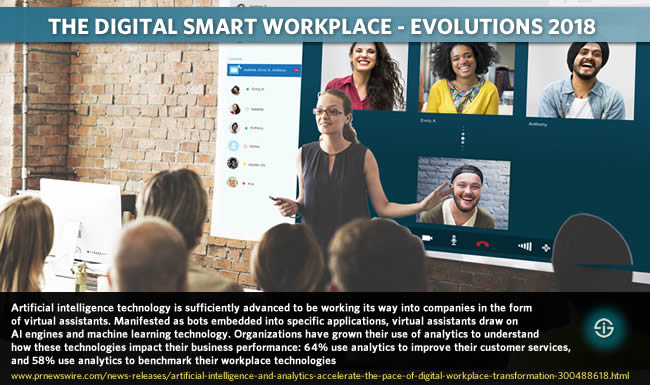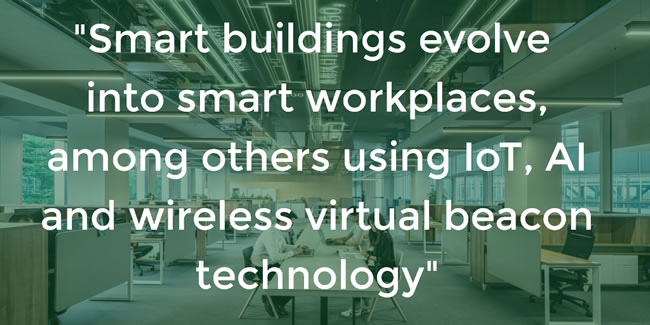Artificial intelligence and the digital workplace already have a pretty long history together in areas many don’t realize. And by the looks of it, the role of AI in smart workplaces is increasing with more recent evolutions in 2018.
Initially mainly focused on areas such as increasing workforce productivity, empowering staff through smart search and customized information and recommendations to save them time and, overall, the leverage of artificial intelligence to enable the change of workstyles as part of digital workplace evolutions, the opportunities for and real-life deployment of AI in smart workplaces are growing.
Collaboration and crowdsourcing, videoconferencing with translation and transcriptions, workplace analytics, platforms in the scope of artificial intelligence in sales and customer service (e.g. virtual sales assistants), tools that connect IoT (the Internet of Things), access control and the reservation of meeting rooms in a smart office scope: the list of smart AI workplace solutions gets longer, making the digital workplace one of the areas where artificial intelligence and business rapidly meet.
Many of the evolutions we now see in the sphere of artificial intelligence in the smarter workplace and the so-called smart office go back at least 5 years but become reality now, at different speeds.

According to the announcement of Dimension Data’s ‘Top IT trends in 2018: digital workplaces’ artificial intelligence will even soon be the norm in the smart workplace environment.
Yet, it’s not just artificial intelligence alone (it rarely is). The top IT trends and role of AI in smart workplaces are also partially about convergence and integration. Moreover, IoT comes in at a maybe less expected level: that of smart buildings. And there is more. An overview.
Analytics and AI in the digital transformation of the workplace
First, a quick step back from the role of technologies and AI in digital workplace perspective. In the Summer of 2017, Dimension Data announced its “Digital Workplace Report: Transforming Your Business” with a strong focus on artificial intelligence and analytics as being key in the digital transformation towards the digital workplace.
The announcement stated that gaining competitive advantages and enhancing business processes were two top goals of the digital transformation strategy of organizations which are moving from a classic office environment to a digital workplace.
In the scope of analytics, AI and the digital workplace, the report showed that 62 percent of respondents expected to implement a typical modern AI smart workplace technology, namely virtual advisers, in their organizations within the next two years. Moreover, 58 percent of participants stated they expected to start investing in the technologies powering those virtual advisors in the next two years.
These virtual assistants leverage AI and machine learning in order to answer still relatively simple queries and are embedded in applications such as bots Dimension Data stated as you can read here.
While it’s true that all in all it’s still early days for such kinds of AI-powered virtual assistants there has been a clear increase in applications leveraging them for various purposes, ranging from use cases in sales, marketing, the bridging of sales and marketing, customer service, contact center operations and in certain industries such as banking, virtual tellers and virtual advisors (also think about AI and robo-advisors in financial applications).
Smart workplace IT trends and evolutions 2018
Fast forward to 2018. In its “Top IT trends in 2018: digital workplaces”, Dimension Data partially draws upon the previously mentioned report and summarizes 5 key IT trends in digital workplace evolutions.
They are also mentioned in a webcast on the findings of the report which you can still attend here and came with an infographic (see below) and a written overview.

So, what are those top 5 IT trends in the scope of the digital workplace and how is the usage of AI in smart workplaces evolving according to Dimension Data?
AI-driven voice-enabled virtual assistants: from voice command to action
First come those mentioned virtual assistants but with a twist: Dimension Data lists AI-driven voice-enabled virtual assistants as a first trend.
In the summary of the 5 trends which you can read here a few examples of applications are mentioned, using Microsoft’s Cortana, one of those ‘voice-activated helpers’. According to delaware’s Maarten Herthoge, the smart workplace will convert voice commands into actions across multiple platforms, learn continuously and create new associations between people, activities, documents and business data.
Smart buildings and the smart office for smart workplaces
A second trend concerns the mentioned smart buildings: buildings where there is an increasing convergence of IT and OT and of systems such as smart office applications, building energy management solutions, building management systems and so forth in the scope of IoT, analytics, IP and increasingly AI at the service of all stakeholders.

According to Dimension Data smart buildings are evolving into smart workplaces, among others using IoT, AI (machine learning) and wireless virtual beacon technology. Examples in the same summary. In smart buildings, in this context non-residential buildings for offices, we indeed see an increasing role of smart office and smart workplace applications as IoT and data are also driving the further integration on the overall facility optimization level and areas such as lighting control, room control, space management, building management in an age of IoT and IoT-enabled office and workplace applications. And, indeed, here as well AI plays a role on several fronts as also in buildings intelligence moves to the edge and of course into the smart office.
The broader adoption of Web RTC – and its impact
Trend number three concerns Web real-time communication (RTC). That’s not new? Indeed, it isn’t states Dimension Data.
However, in 2018 we’ll see a growing adoption because some of the major browser vendors now support it. Web RTC indeed is essentially mentioned in the scope of conducting video meetings. Web RTC uses a browser without the need for a client. However, the importance of Web RTC, developed by the World Wide Web Consortium shouldn’t be underestimated as it does make real-time conferencing and communication in the browser much easier with high quality and audio and, when broadly adopted, far more possibilities and applications. It’s the latter that is happening.
The growing adoption of Web RTC should also lead to novel ways to engage customers and enhance the customer experience as Dimension Data mentions..
Video already was ubiquitous – now smart workplaces are (re)designed to support it
Next comes video. Indeed not exactly new either but according to Dimension Data video now plays such an important role that organizations redefine their workplaces.
They move away from traditional set-ups to shared spaces (‘activity-based working’) with some smaller office spaces where people can collaborate and conduct video conferences. So, the digital workplace adapts to be more supportive of video. There is of course also a link with Web RTC and, in fact, though not mentioned, AI is playing an increasing role in video conferencing, e.g. with automated transcription. As Maarten Herthoge puts it, video conferencing systems are able to transcribe your spoken conversation for later reference or even translate in real-time. Do note that the infographic also mentions augmented reality. The arrival of AR and VR for immersive experiences in the digital workplace indeed has been predicted since quite some time and is again an area of convergence with, among others, video, data, IoT and AI.
From BYOD and BYOx to Bring Your Own App
Last but not least comes good old BYOD (Bring Your Own Device), albeit it in the broader scope of consumerization and BYOx (Bring Your Own Everything).
Dimension Data mainly sees a rise of BYOA in 2018: Bring Your Own App. Calling it the next wave of individual empowerment, Dimension Data gives an example using WhatsApp and focuses on how BYOA will impact the organization and the IT team.
You can read more about the 5 IT trends Dimension Data found here.

The transformation of the workplace: where we are and come from
Going back to the report from July 2017 Dimension Data’s Robert Allman believes that mobility is pivotal to a digital workplace.
Allman: “Business leaders and CIOs are switched on to the importance of mobility in the digital workplace, with an even mix of companies supporting company-provided and employee-owned devices in the work environment”.
Also analytics take center stage. Krista Brown, Dimension Data’s Group End-user Computing SVP: “Organizations have grown their use of analytics to understand how these technologies impact their business performance: 64% use analytics to improve their customer services, and 58% use analytics to benchmark their workplace technologies.”
Still, there is also quite some work to be done in the transformation towards a digital workplace. While 30 percent of companies say they are already far and reap the benefits for others it’s still early days, with corporate culture being one of the reasons holding companies back according to Brown.
Obviously the evolution towards digital workspaces and workplaces is one at different speeds, this also goes for the use of technologies and the exact use cases.
Mobile and mobility, BYOD and the consumerization of IT, social, cloud and data analytics have been playing an important role in these evolutions over the past decade where the mantra that work is an activity rather than a place was omnipresent.
We’ve seen a few large organizations move their remote workers back in the office since then. Still, as the video below mentions, 40 percent of responding organizations in the digital workplace report have employees working full-time from home, a percentage to increase to 56 percent in two years. For employees working part time from home the expected increase is even higher.
A lot of focus in the digital workplace evolutions has gone to the entry of new generations of workers in organizations, even a bit too much. While it’s true that this has been one of the main reasons why workstyles evolved, the possibilities for organizations to leverage behavioral analytics in the digital workplace, as is the case in digital workplace or workforce analytics to increase productivity, also are important and were mentioned in previous editions of the report.
Drivers of the digital workplace and the role of AI in smart workplace transformation in context
All in all it’s a mixed reality with those mentioned different speeds and of course about more than technologies.
Organizations that successfully moved into the direction of the digital workplace, leveraging some of the applications in areas such as collaboration, know that guidance and a bit of change management is needed too. The same goes for what you do with the insights gained into workforce productivity. While guidance often indeed is a generational phenomenon (the so-called less digital savvy worker de facto often can use some help in optimally leveraging digital workplace solutions than those younger generations), it’s important to take the individual worker into account and also look at the efficiency of processes of course.
As far as AI is concerned, for instance in digital workplace analytics, there is more than virtual assistants and the application of AI in, for example, video conferencing. Platforms which automatically filter the most relevant answers in ideation and group discussions exist since far over a decade. Also expect an increasing usage of AI in the line of business applications worker use, the ongoing usage of AI across silos to offer employees the information they need to do their job in an ocean of unstructured data and communications, reducing the time they need to search for it, the smart office and far more.
Also look at specific areas of work and applications we use to work. AI is, for example, poised to change ERP with intelligent ERP, performance management and corporate performance management, CRM, ample solutions in the scope of AI in sales, marketing and customer service (with among others tools for salespeople which offer predictive forecasting or enable coaching to improve call efficiency) and vertical applications (e.g. healthcare).
Just as AI helps increasing selling bandwidth and enhancing sales productivity it enables increasing bandwidth of workers in other areas and provides deeper insights on all levels, inevitably also impacting customer experience.
However, AI is not just about increasing bandwidth, it’s first and foremost about finding the right digital workplace balance to augment worker efficiency and increase engagement. With an increasing focus on personalized information leveraging AI, immersive technologies, workspace planning, learning applications such as micro-training, performance dashboards and contextually relevant insights, the balance to meet the goals of all stakeholders in this increasingly connected and data-driven reality which the digital workplace, among others, stands for, is paramount, also in leveraging AI, IoT and all the other mentioned platforms, use cases and technologies.
Finally, as far as all those technologies such as IoT, advanced analytics, cloud, mobile and AI in smarter workplaces is concerned, once more the keyword is convergence.
More about the report in the press release and on its homepage. You can of course also download the report, listen to the webinar, and go through the infographic, embedded above, which also contains additional context, specifically regarding the 5 mentioned IT priorities in smart workplace transformation.
Top image: Shutterstock – Copyright: Rawpixel.com – All other images are the property of their respective mentioned owners.

